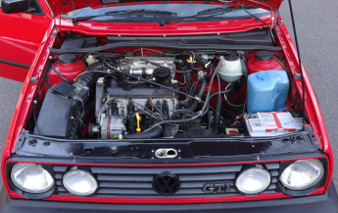Retro rides don’t carry any more kudos than the Mk2 Golf. It’s strong, practical and still affordable – and because panels, trim, service parts and accessories are all still readily available, there’s no limit to what you can do at home on your driveway. So here’s our top 10 buying tips to help you sift the nuggets from the nails…
1. Rule out rust
Body condition takes precedence over everything else and you’ll be able to rule out the rubbish within a few minutes of viewing a car for sale. Worst hit areas include the sills, wheelarches, door bottoms, rear valance, suspension struts front and rear, the seam where the floor panel meets the sill and the metal around the base of the windscreen. The lower bulkhead, front suspension subframe are also known troublespots, so if you’ve got this far – take time to carry out a proper inspection.

2. Neck it down
The Mk2’s fuel filler neck crumbles just like the Mk1’s and any rot can drop down into the tank and eventually find its way into the fuel system. Worse scenario is if the injectors on a GTi become contaminated, or you end up having to flush out the fuel tank as well as replacing the neck itself. Ouch!
3. Blues and lose
Blue smoke isn’t good – it points to worn valve guides or valve stem seal failure, in which case you’ll need to carry out a cylinder head rebuild which won’t be cheap.
4. History lesson
Quiz the owner about maintenance and ask to see evidence of previous servicing. If routine stuff like oil and filter changes (they should be done every 5000-6000 miles) have been ignored, expect the worst. Cambelts should be replaced every 60,000 miles/four years, so if it’s due another one soon bargain accordingly (£250).
5. Running rough
That Pierburg 2E2 carb wasn’t great, so if a Mk2 misfires or generally runs rough this could be why. Lots of owners will have converted to a Weber 32/34 and fitted a manual choke, but there’s no reason why you can’t buy a kit and refurbish the original if it needs doing (around £40).

5. Shock horror
If a car’s sitting down on one side suspect a broken coil spring, but if it feels unresponsive generally plan on doing a suspension refurb. Those original oil-filled shocks tend to leak when they get old, so upgrade them with gas-filled items instead.
6. Stop it!
Golf stoppers aren’t bad, although GTi rear calipers have an appalling reputation for seizing so if a car pulls to one side, suspect problems. Replacements are available, although it’s better to upgrade to Mk4 calipers long term so haggle hard to cover the cost.
7. Bypass the bodges
The best cars are usually those that haven’t been botched already so view with suspicion Mk2s owned by clowns that haven’t been able to resist the urge to modify and fiddle on the cheap. That said, if a car comes with silly wheels and lots of naff accessories thrown in – you could always flog them on eBay to fund more worthwhile upgrades.

8. The heat’s on
Inside, it’s a case of checking condition and seeing if everything works. Don’t be rushed, so if electric windows are fitted, make sure they work. Also, check the blower fan functions on all three speeds otherwise you’ll need a new fan pack. Heater matrix problems are common (and tricky to fix) – wet carpets in the passenger footwell is a tell-tale sign.
9. Wipe and see
If the rear wiper doesn’t work, assuming the motor’s not seized, suspect the wiring because it often frays with age as it exits the body and goes into the tailgate. Again, use it as another excuse to haggle the price down a bit.

10. Don’t pay too much
The cheapest Mk2s start at under a grand and the bottom end for a car with a valid MoT is £1500, so unless it’s really straight bodily don’t get carried away spending lots more on one that needs cash throwing at it. The 16v GTi is sought after and commands a premium over the 8v, although not everyone likes its highly strung character so try before you buy. Expect to pay at least £1,500 for a scruffy GTi, roughly £5,000 for a nice one and £8,000 tops for a real minter. Part finished projects are okay, especially if they’ve had a worthwhile engine swap, but be fussy about the standard to which the work’s been carried out because, as we’ve said, you don’t want to inherit someone else’s corner-cutting.
Happy hunting!
Ian
The opinions expressed here are the personal opinions of the author and do not necessarily represent the views and opinions of VW Heritage
This post is also available in: Deutsch (German)

